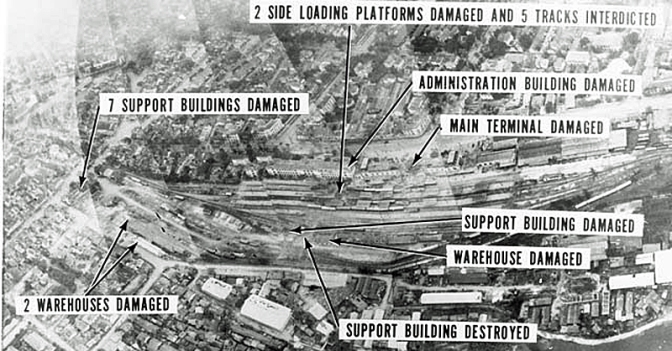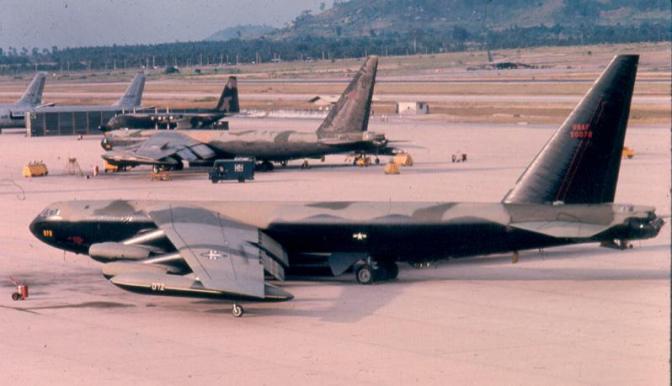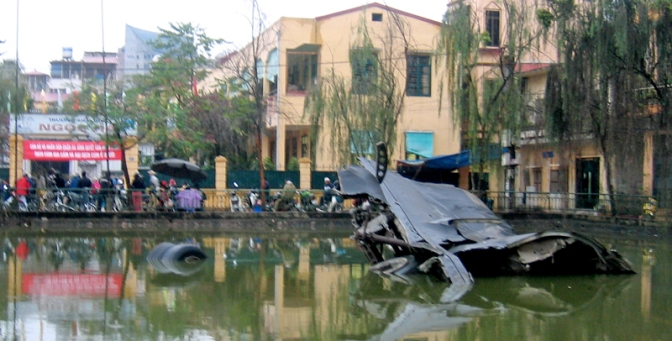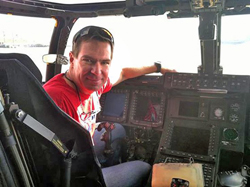B52 Shut Down 2 Engines Fighter Story Funny

Aerial gunnery is an antiquated concept in modern air combat.
In the age of cruise missiles, stealth and BVR (Beyond Visual Range) engagements the idea of aviators dueling with guns at close range is largely obsolete.
So it was on Christmas Eve, 1972 above Hanoi, North Vietnam. A massive bomber force of B-52G and tall-tailed, big-bellied B-52D's streamed toward Hanoi for the relentless pounding of North Vietnam called Linebacker II.
The idea, perhaps tacitly, was to force the North Vietnamese back to the bargaining table at the Paris Peace Talks. Nixon had issued an ultimatum earlier in the month. He directed Secretary of State Henry Kissinger to warn Hanoi that if they didn't return to the negotiating table in Paris within 72 hours North Vietnam would face "grave consequences". Those consequences were to be administered by the B-52 Stratofortresses from Andersen AFB in Guam and Utapao Royal Thai Air Base in Thailand. Christmas was coming, the budget for bombing was running out and a new Congress would soon sit. They threatened to end the Vietnam Conflict with legislation instead of lethality.
For the 43rd, 72nd and 307th Bomb Wings of the U.S. Air Force Strategic Air Command it was crunch time. Get the job done or lose the job to the new Congress.
The B-52 is a horrific weapon in its tactical/conventional role. It has struck terror in the enemy from the Viet Cong to the North Vietnamese to Saddam's Republican Guard and to Bin Laden's Al Qaeda at Tora Bora. To this day the Stratofortress serves as a capable "bomb truck" that can loiter above troops in contact and drop precision guided weapons designated by ground forces or other aircraft and obliterate entire grid squares with hell-thunder carpet bombing. The few people who have survived a B-52 strike describe it as an unimaginable cauldron of deafening noise. The earth heaves in fatal seizure as fire and shards of red-hot shrapnel fill the air like a plague of Satan's locust. After B-52 strikes in the Gulf War thousands of Saddam's "elite" Republican Guard abandoned their weapons and marched south with their hands in the air. Such is the terror of the thundering death rained from the stratosphere without warning by the B-52.

Strategic aerial bombing had come a long way, or so we thought, since WWII. Especially according to the Strategic Air Command and their original boss, General Curtis LeMay.
LeMay nuked Hiroshima and Nagasaki and gone on to preside over the formation of a nuclear deterrent force that was trained to race over the North Pole and attack Russia. LeMay's doctrine of high, fast nuclear megadeath even gave brief life to the new XB-70 Valkyrie triple-supersonic high altitude bomber. But the Valkyrie died in a midair collision over the western U.S. desert during a publicity photo shoot soon after LeMay had been put out to pasture in retirement as think tanks began to envision a different kind of air war, a tactical air war with strategic goals that mixed bargaining table with bombing runs to leverage compliance through diplomacy along with carpet bombing.
So that night, in the skies above Hanoi, bombers designed to attack Russia from high altitude after racing over the arctic were now raining iron bombs on the North Vietnamese in a series of raids that looked more like the B-24, B-29 and B-17 missions in WWII than some futuristic vision of air war.
And the North Vietnamese were ready.
Old ideas die hard in military doctrine so, while the XB-70 had no provision for self-defense machine guns like the ancient B-17 Flying Fortress, B-24 Liberator and B-29 Superfortress from WWII, the B-52 retained at least lip service to self defense in the form of a tail gunner. He manned a deadly quadruple stinger of four .50 caliber machine guns aimed remotely from his cupola in the tail of the Stratofortress. Most of the time he was a bored passenger in the back of the B-52 on a bombing mission, but during Linebacker II, he would earn his pay, and his gunpowder.

Air defense above Hanoi was interlaced with guns, missiles, radars and MiGs in a lethal gauntlet bent on decimating the American bomber streams. It was the "flying telephone pole" SAM missiles the American bomber crews feared the most. Not the MiGs. The Soviet Built SA-2 Guideline missile was a morbid predator of American bomber crews. Beginning in a glowing flash from its launch rail tens of thousands of feet below, the SA-2 SAM flying telephone pole would arc upward toward the bomber stream as the B-52 tail gunners watched helplessly. They hoped the missiles would run out of fuel, fail to track accurately and fall away. Most of the time they did. But not always. When I visited Hanoi in 2002 government officials proudly showed me the helmets of downed B-52 crewmembers in a glass case and touted the wreckage of a B-52 stuck in a lake in the center of Hanoi as a great monument to the Communist victory in the "American War".
The North Vietnamese were good at using their SAM missiles. The Russians had taught them. During Linebacker II they would launch over 1,000 of them. And along with the low and medium altitude flak and high altitude SAM missiles came another threat- Communist MiGs.
The MiG-21 and MiG-17 are both capable interceptors, especially the '-21, NATO codename, "Fishbed". They can both get into the air quickly from airfields around Hanoi and, if they survive fratricide from the SAM missiles buzzing upward like angry bees from a broken hive, it is easy for them to find the B-52's. Both MiGs bristle with cannons and the MiG-21 can mount Atoll air-to-air missiles, a capable knock-off of the American Sidewinder. They are a genuine threat to the B-52's raining dynamite-death on Hanoi.
This night 22 "Big Belly 'D's", B-52D Stratofortresses with their distinctive high tail and sinister camouflage cloak over a gloss-black belly, will hit the steel mills at Thai Nguyen near Hanoi in the hopes of further destroying the Communist infrastructure. This bomber stream will launch from Thailand, in much the same way as B-29's launched from the Marianas during WWII.

Inside the tail of the B-52D named "Diamond 'Lil", aircraft number 55083, USAF Airman 1st Class Albert Moore from San Bernadino, California will be manning the Browning quad .50 caliber machine guns. He is only 18. Almost exactly like his forefathers in the tail of the B-17 Flying Fortress or a B-24 Liberator, Moore's task is lonely and tedious. It is over half a football field from where Moore sits at his gunnery station in the tail (actually, behind the tail) of the B-52 to where the flight crew, navigator, bombardier and radioman sit. In between them are tons of high explosives packed into the aircraft, up to 88 general-purpose 500 pound bombs.
If the mission succeeds the 22 tons of bombs they are carrying will turn Thai Nguyen railway into a moonscape. Tonight the B-52 Moore is flying in is call sign "Brown Three".
The mission was relatively routine even following bomb release. Then it changed.
Moore saw a fast moving, green blip on his radar screen. It arced from upper left toward center. The radar contact was low, below the bomber stream. Moore noticed it at the 8:30 position of his screen, ascending on what appeared to be an intercept vector.
It is coming to kill them.
The B-52 is absurdly vulnerable to fighters. Without an escort shield like the B-17's and B-24's had in world war two from their P-51 Mustangs, the B-52's over Hanoi were lumbering sky-cows ripe for a MiG slaughter. It's takes a few grid squares to turn a B-52. In formation at night, that is impossible without the risk of midair collision. It is easy to imagine the North Vietnamese MiG pilot racing up to decimate the B-52's must have known this would be easy. With the massive heat signature from eight engines on the B-52 and its non-existent maneuverability the MiGs could be… almost leisurely in their predation.

We don't know what happened inside the cockpit of the MiG-21 that lit up Airman Moore's radar screen that night. To this day the Vietnamese are guarded about many aspects of the "American War". But it is easy to imagine the MiG pilot arming his Atoll air-to-air missiles, cheap flight gloves covering an index finger moving to the trigger on the center of the MiG's control stick. Left hand continuing to advance the throttle. Climbing, climbing… ahead and above the night sky framing the giant swept wing bombers that grow larger in the MiG's windscreen by the second…
Moore calls the contact to the rest of his crew over the intercom inside the B-52. He sees it is climbing to kill them, and realizes he is their only hope. Whether it is B-52's and MiGs over Hanoi in the 20th century or stones and cavemen, it is all the same, one man will die, one will live. These next few seconds will decide.
The pilot takes what evasive maneuvers he can, wagging the B-52 slightly in the night sky. It is a useless gesture against the nimble MiG, like a goat tied to a post before a tiger.
The 18-year old Moore orders chaff and flares, countermeasures designed (quite poorly) to confuse the MiG's ability to use radar or infra-red heat signature to lock onto the B-52 for a missile shot or a cannon pass. The bright magnesium flares rocket outward from the B-52 in an arcing fan, swirling in its vortex to create a dazzling display that ruins the MiG pilot's night vision of the giant bomber. Clouds of metallic confetti chaff fill the air like a panicked buffalo emptying its bowels after a lion's pounce.
The chaff and flares do nothing.
Hauntingly, the MiG seems to dangle motionless on the radar screen behind the B-52. It is beginning to match speed and altitude. For a firing solution. Moore knows what he must do to save the airplane and crew.
Unlike the gunners in a B-17 or B-24 during WWII the gunner in a B-52 does not hold onto the gun itself. He does not feel all of the recoil from the big Browning .50 caliber machine gun in his spine. He does not swing the barrel of the machine gun against the maelstrom slipstream through an open window in the bomber. He likely never even sees the plane he is shooting at. It is only a blip on a radar screen, like an early video game. Moore controls the four .50 caliber machine guns from his station slightly above and behind the guns. The four guns are mounted in a large gimbal. He moves the gimbal with his gun controls, anticipating the path of the oncoming MiG.
Moore angles his shot down and left of his B-52. He must fill the sky with hot lead in the flight path of the MiG and hope it flies into his bullets.
He will have one chance before the MiG has an opportunity to fire on the wallowing Stratofortress.
Clamping down on the trigger control the four big Brownings buck underneath Moore, rocking back and forth from their recoil and sucking in belts of bullets through a metal feed rail. Given the airspeed of the B-52, the ballistic trajectory of the bullets and the angle, closure rate, speed and altitude of the MiG this is, literally, a longshot.
His first burst misses.
Moore steadies himself as though it mattered in the wagging tail of the squirrely B-52. He sends another streak of .50 cal tracers arcing in front of the MiG.
Nothing.

Time is running out. The MiG will attack in the next few seconds. Moore has one final chance. He fires his longest burst, thousands of rounds going through the feed rails, into the four guns and arcing into the night sky. The gun barrels begin to overheat. He is running low on ammunition.
Airman Moore cannot see what happens through his canopy, but on his radar screen the MiG seems to glow… even brighter. The radar contact "…grows to three times its size" Moore would write in his after-action report.
In the tail of another B-52 Tech Sgt. Clarence Chute sees the MiG get torn apart when its flies through the death-ray arc of Moore's bullets. Chute, the only eyewitness to the MiG kill, later wrote, "Several pieces of the aircraft exploded, and the fireball disappeared in the under-cast at my 6:30 position."
There is no official record of who was flying the MiG-21 that attacked Moore's B-52. The North Vietnamese did not acknowledge the loss. The pilot of the MiG remains anonymous, a flyer doing his deadly job. When I asked about the loss of MiG pilots during Linebacker II on a visit to Hanoi the government appointed guides feigned misunderstanding of my question. They only mentioned there were "…many heroes…"

For his incredible aerial gunnery, gallant and courageous defense of his aircraft and crew, and calm repose under imminent attack Airman 1st Class Albert Moore was awarded the Silver Star, the third highest award for valor in the U.S. military. Moore's aerial victory was one of two by B-52 gunners during Linebacker II. About a week earlier USAF Staff Sergeant Sam Turner had also downed a North Vietnamese MiG-21 with the tail gun of his B-52.
By December 29, 1972 the U.S. Air Force was running out of targets for their B-52's. Strategic bombing operations north of the 20th parallel were stopped. Industrial targets in North Vietnam were in ruins. But still the North Vietnamese and Viet Cong fought on. On January 2, 1973 peace discussions in Paris resumed. It is widely believed among U.S. experts, and staunchly denied by Vietnamese experts, that the Linebacker II strikes forced the North Vietnamese back to the bargaining table.
Regardless of the political ramifications of Linebacker II it would remain one of the largest strategic bombing campaigns in history, and depending on whose metric you use, the most successful. It was also the last bombing campaign in which U.S. heavy bombers shot down enemy aircraft using guns in an air-to-air engagement, and the B-52 Stratofortress remains the largest aircraft in history to have shot down another aircraft in flight using guns.
 Alert 5 contributor Tom Demerly has traveled to all seven continents and written for numerous publications including Outside magazine. He still can't fly anything bigger than a Cessna.
Alert 5 contributor Tom Demerly has traveled to all seven continents and written for numerous publications including Outside magazine. He still can't fly anything bigger than a Cessna.
Source: https://tacairnet.com/2015/01/01/gunfight-the-b-52-mig-kills-of-linebacker-ii/
Post a Comment for "B52 Shut Down 2 Engines Fighter Story Funny"